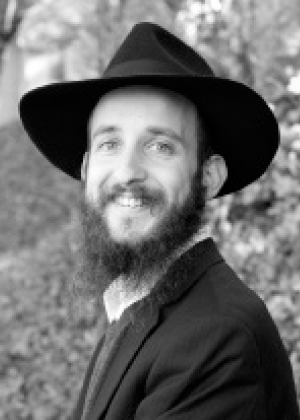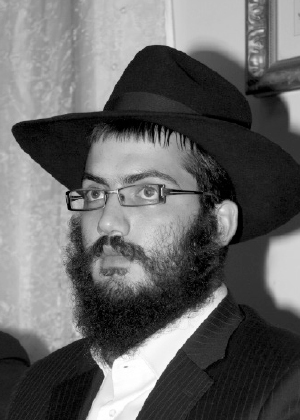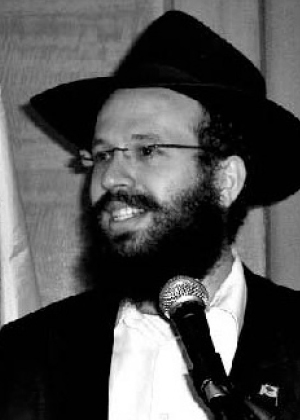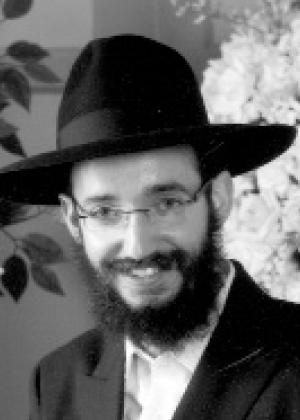My Shlichus
Shlichus Profiles:
 Rabbi Oren Raz
Rabbi Oren Raz
Location: S. Cristobal, Mexico
Population: 300,000
Jews: about 30 locals and dozens of tourists a week
Type of Shlichus:
Chabad House for tourists and outreach to locals
We arrived in S. Cristobal about three and a half years ago. The town has the old Spanish colonial look and is a pretty place, located in the Chiapas state of Mexico. It is surrounded by numerous tourist attractions like waterfalls and jungles and it isn’t far from the Sumidero Canyon. As with every tourist spot in the world, here too, Israelis come in droves and there is much work to be done with them.
Our trial by fire was the first Tishrei, when 150 people joined us for t’fillos and Yom Tov meals. Israeli tourists sat alongside local Jews who were celebrating Rosh HaShana properly for the first time in their lives. Since our arrival here, many people visit the Chabad House to learn or for Shabbos meals. We also opened a kosher restaurant and store to service the hundreds of Jewish tourists.
In accordance with the Rebbe’s instruction that all outreach much be permeated with preparing the world for Moshiach, we talk a lot about this in shiurim, at Shabbos meals, and at every opportunity. The topic of Moshiach is usually readily accepted but even when there is the occasional resistance, we see how the Rebbe works things out and opens people’s hearts to hear it.
Among the guests at our Shabbos table was Itai, a young Israeli for whom even showing up at a Chabad house was out of the norm. For many months, he was in the process of learning about religion through lectures broadcast on the Internet by various rabbis who in the course of their teaching throw in attacks against Chabad and the Rebbe.
This was the first time he agreed to join us for a Shabbos meal. At the beginning of the meal I saw how suspicious he was of us; it looked as though he was trying to catch us red-handed. Since we are a Chabad House and not merely a warm place for Israelis to visit, we decided to stick to our approach and not to resort to pretense.
My children told about the first shliach, Avrohom Avinu, who “caused Hashem’s name to be called out by every passerby,” and we urged our guests to strengthen their Torah and mitzvos. Until that point, everything went smoothly, but when the conversation turned to the Rebbe and his global activities as Nasi HaDor and Moshiach, Itai’s face turned red and he looked like a pressure cooker about to explode. He couldn’t take this, for it went counter to all the lessons he had learned on the Internet.
I told him that before dismissing something, it was only right to examine it. I offered to learn with him for a week. But my words fell on deaf ears. I was upset about this, especially because of the negative atmosphere that had been created that spoiled the Shabbos meal.
Two days later I went out on mivtzaim to where the tourists hang out. When I arrived at a hostel where most of the Israelis stay, I saw a commotion outside. A fire that had broken out in the hostel had caused a gas balloon to catch fire and now there were some Israelis trapped inside.
After some nerve-wracking minutes, those who were trapped managed to get out, miraculously. Seeing me with t’fillin, they ran over to me and gave vent to their emotions by putting on t’fillin. Among those standing on line I saw Itai who asked me emotionally, “Rabbi, when are we going to start learning together?”
 Rabbi Shmuel Serebryanski
Rabbi Shmuel Serebryanski
Location: Eastern Orange County, NY
Population: 327, 813
Jews: 11,000
Type of Shlichus: A community, education, women’s activities
We went on shlichus four and a half years ago to Eastern Orange County, New York to spread Judaism to Jews in Newburgh, New Windsor and Cornwall. Boruch Hashem, we feel the Rebbe’s brachos every step of the way and see amazing things in the Rebbe’s answers in the Igros Kodesh.
When we started out, we would often meet Jews who were amazed to hear they were not the only Jews in the area. When they heard about our activities and the number of Jews who participate, they were shocked. During Tishrei, many Jews approached us with tears in their eyes and told us how their lives changed because of a visit at the Chabad House and how much Jewish pride they now feel.
As in many locations in the US, the rate of assimilation is very high and most Jews are intermarried. Obviously, their Jewish knowledge is minimal to zero. But despite that, you can find and arouse their pintele yid rather easily.
Here’s an example. I met with a Jewish doctor married to a non-Jew after getting information about him from a religious doctor who works in a nearby office. The religious doctor opined that his colleague was as far from religion as east is from west. I wasn’t willing to give up before I started and I arranged an appointment. When we met, the irreligious doctor was so moved that he began telling me about his Jewish name and about the Jewish education he received as a child. Although he is so distant, he feels he cannot escape his inner truth, his neshama. We spoke at length and he tried to extend our conversation. Before we parted he gave me his email address and when a day later he received my weekly email with a d’var Torah, he warmly thanked me for it.
I had another interesting experience when I met a Reform ‘rabbi’ a short time after we arrived here. When I entered his office, I was surprised to see a set of Lessons in Tanya on his desk. At my look of astonishment he said that when he saw that many Reform Jews were leaving their communities for Chabad he came to the conclusion that the power of Chabad is in Tanya. So he decided to give a Tanya class to his congregants so they wouldn’t leave!
After we became better acquainted, he asked me whether I’d be willing to learn Tanya with him so he would be better prepared for his weekly class. I agreed and he also invited the Conservative rabbi. So now you have the Reform and Conservative clergy learning Tanya together with the local Chabad shliach! When we learned about the “tzaddik yesod olam,” they wanted to know how the world exists now after Gimmel Tammuz. I explained that the Rebbe continues to lead our generation…
 Rabbi Yosef Yitzchok Asman
Rabbi Yosef Yitzchok Asman
Location: Kiev
Population: 3 million
Jews: Tens of thousands including thousands of Israelis
Type of Shlichus: The Israeli division and yeshiva
I grew up on shlichus as the son of the shliach to Kiev, Rabbi Moshe Reuven Asman. I intended to return to Kiev when I married and to work on shlichus here. My wife, from the Pizem family, also grew up on shlichus and so, a few months after our wedding, Adar I 5771, we returned to Kiev.
Kiev is outstanding for its many institutions and programs. There are the schools, the Brodsky shul which is a Jewish center, a yeshiva, a smicha program, an evening kollel, etc. I give shiurim in the yeshiva programs.
I also fulfilled a dream in founding a division for Israelis within the Jewish Chabad community. The thousands of Israelis living in Kiev need attention and someone to relate to their mentality; there is so much more that can be accomplished.
I work with the Israeli embassy employees in the Ukraine which is located in Kiev. I often noticed a security guard who, on principle, refused to put on t’fillin. One time, when I found the group of security guards in one room, I locked the door and they all put on t’fillin except for him. Then peer pressure was exerted on him, “You take warm challos from the Chabadnikim and enjoy them but you’re not willing to put on t’fillin?”
The guy finally relented and put on t’fillin. He then told me that the reason he had refused until then was only because, coming from a kibbutz, he had never put on t’fillin, not even at his bar mitzva, and he did not know how to do it. Since that initial plunge he puts t’fillin on every time. Furthermore, when his family came to visit him on Sukkos, he brought them all to me to shake the dalet minim. This was someone who until then had no knowledge whatsoever, even about Yom Kippur!
We also operate a mitzva tank which has pictures that include the Seven Noachide Laws and Yechi and the tank crew proudly publicizes the Besuras Ha’Geula and the Goel.
 Rabbi Yosef Yitzchok Levy
Rabbi Yosef Yitzchok Levy
Location: Manila, Philippines
Population: 100 million
Jews: about 200 Jewish families live in the Philippines and a thousand tourists visit the area every year
Type of Shlichus: a community, Jewish education, a kosher restaurant, tourists
My wife and I went on shlichus six years ago. We had never been to the Philippines before we arrived and knew almost nothing about it, but after opening to amazing answers in the Igros Kodesh, we just jumped in. We packed a lift and landed in this distant and foreign country a few days after our first anniversary.
The Philippines is a third world country, both in mentality and in day to day life. We shop in the local market, buy a whole fish and have to clean it. To get chalav Yisroel we need to go to a distant farm, about an hour from the capitol, and milk the cows ourselves. Anything we want to cook or bake, we have to do ourselves. There are no shortcuts and no kosher products that we can buy from a neighborhood grocery store. We arranged for kosher sh’chita by flying in a Lubavitcher shochet.
Being pioneers isn’t easy but we know that we are working for the best employer in the world with the broadest possible shoulders. We feel the personal connection with the Rebbe on a daily basis and this fantastic z’chus, to be the Rebbe’s shluchim in such a fateful time, in these final moments of galus, and to do the only remaining shlichus, to prepare the world to welcome the Rebbe MH”M.
At the Chabad House in the Philippines, miracles are a daily reality. There are big and small miracles. We see how the Rebbe is the balabus here. The Chabad House is for tourists, businessmen and of course, for those who live here on a permanent basis. In addition to our outreach to the local Jews, there are also local gentiles who want to get close to G-d and fulfill the mission for which they came to this world. They come to us to learn about the Seven Noachide Laws.
One Pesach, more than 200 Jews attended the public Seder with us. The Chabad House building contains a shul, kosher restaurant, mikva, school, Judaica store, and more.
 Rabbi Yisroel Springer
Rabbi Yisroel Springer
Location:
The “Sukkas Sholom” shul in Ramat Gan
Type of Shlichus:
Shul, shiurim and activities around the year
In my earliest memories there is a memory of knowing that one day I would join the army of shluchim. It helped that my wife grew up on shlichus on the moshava Atlit near Haifa. Shortly after we married we moved to Ramat Gan to develop the local programming there which is all permeated by the only shlichus – kabbalas p’nei the Rebbe MH”M.
Shortly after we arrived it was Tishrei. We were still settling into our new home while we began reaching out to the community.
On the morning of Yom Kippur, I was standing near the chazan, leading the longest t’filla of the year. The short time that had passed since we had arrived did not enable us to meet the local people and most of the congregants in shul were older people who had always been there. So my attention was drawn to the two people who suddenly peeked into the shul. The two were a father and son who felt the need to go to shul on this holy day, but they politely declined my warm invitation to come in. The father apologized, “I’m a Kohen.” I said, “On the contrary, that’s great, you can give us the priestly blessing.” But he said, “I am not shomer Shabbos and I would not feel comfortable going up to duchan and bless the congregation.”
I said, “If that is what is holding you back from praying, you can say the priestly blessing from your place without going up to duchan.”
Some time later he told me that this simple answer won him over, the idea that he could contribute his blessing to us while remaining in his place.
Now, many years later, quite a bit of the activities we do is to the credit of this man. He became a close friend of ours. He introduced us to new people, connected us with key figures in the local institutions, and helps in every way he can. When we had to be away during the weekly shiur which takes place in our house, he hosted the shiur in his own home.
This shiur is an opportunity for the participants to connect to the Rebbe. Besides the learning of the Rebbe’s teachings, every week many of them stay on after the shiur to write to the Rebbe. We are often witnesses to open miracles.
Other members of the community also enjoy lending a hand in our work. For my birthday farbrengen, which took place in my house, many of the mekuravim showed up. During the farbrengen an idea came up, that we should start the week with a video of the Rebbe. Each one announced his pledge toward the cost of buying a new plasma large screen. Together, they came up with half the amount. The surprise came a few days later when one of the mekuravim announced that a large electronics company had said they would donate the rest of the money.
So the weekly video was added to the shlichus ha’yechida – the people in shul watch a video of the Rebbe with the highlight being the singing of Yechi. Not surprisingly, they all accept it happily.
 Rabbi Yeshaya Shagalov
Rabbi Yeshaya Shagalov
Location: Rutgers University, NJ
Population: 45,000 students
Jews: 4000 students
Type of Shlichus: shiurim, t’fillos, and activities with religious students
At Rutgers, we feel every day that the shlichus is to prepare the world to welcome Moshiach. Rabbi Carlebach’s magnificent Chabad house, together with the terrific work of R’ Boruch Goodman, are testimony to the Rebbe’s brachos. We joined their successful team.
At Rutgers, there are many students from religious homes, some of them even from yeshivos. We provide shiurim on inyanei Moshiach and Geula and one-on-one learning. It’s astonishing to see how ignorant people are on the subject. The ignorance leads to stigmas and various complaints which disappear as soon as they open the s’farim and start learning the sources in depth.
The same is true in our outreach to the nearby neighborhood of Highland Park which has a nice religious community. One summer, about a hundred children attended a two month camp program that my wife ran and we saw nice results from that effort.
Being near Brooklyn gives us the opportunity to bring students directly to the source and we take advantage of various opportunities, such as Simchas Beis HaShoeiva and significant farbrengens. On the one hand we see that whoever comes gets excited; on the other hand, we see a lot of reluctance to enter the world of Chabad. We see the truth of the HaYom Yom that Nigleh is water and people are drawn to water, while Chassidus is fire and people flee from fire. Our job is to reassure them that there is nothing to fear since “Hashem your G-d is a consuming fire.”
 April 29, 2015
April 29, 2015
Reader Comments